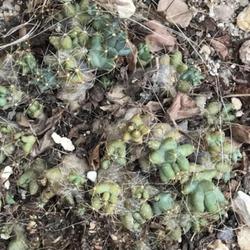Through a feat of botanical quantum mechanics, this taxon has been deemed by the CoL to be both subspecies of Pelecyphora macromeris. Or are there even any subspecies? An existential question.
This result is an artefact of the renaming of this plant from Coryphantha macromeris to Pelecyphora macromeris, based on genetic analysis. The paper describing this move names Coryphantha macromeris as a synonym for P. macromeris (on this the CoL disagrees) and C. macromeris subsp. runyonii as a synonym for P. macromeris subsp. runyonii (on this the CoL agrees).
https://www.ncbi.nlm.nih.gov/p...
To be clear, here is why the CoL is treating this taxon as two things at once. It is subsp. macromeris (according to the CoL) because Coryphantha macromeris (the entire species) is given as a synonym of P. macromeris subsp. macromeris. It is also subsp. runyonii (according to the CoL) because Coryphantha macromeris subsp. runyonii is given as a synonym of P. macromeris subsp. runyonii. Note also that according to the CoL, no form of Coryphantha macromeris is given as the synonym of Pelecyphora macromeris, despite the simple renaming of the species (and subsp. runyonii) in the paper describing this move. No reassortment was applied to the subspecies in the paper.
The difference between the two subspecies has to do with the color (runyonii is gray-green, not dark green or blue-green), shorter stem length (up to 3 inches instead of 9 inches) and restricted area of origin (near sea level on the Rio Grande/Rio Bravo plateau, in southern Texas and northern Mexico).
The reason for the recent move to Pelecyphora (preserving both subspecies in the paper documenting the change) is that this particular species is outside the group spanning all the other Coryphanthas and more closely related to various species of Pelecyphora. There are also floral similarities (fimbriate outer tepals). For what it's worth, the flowers of this species are apparently impossible to distinguish from those of P. vivipara, so be careful relying on this feature alone for identification.
